Tag: economic trends
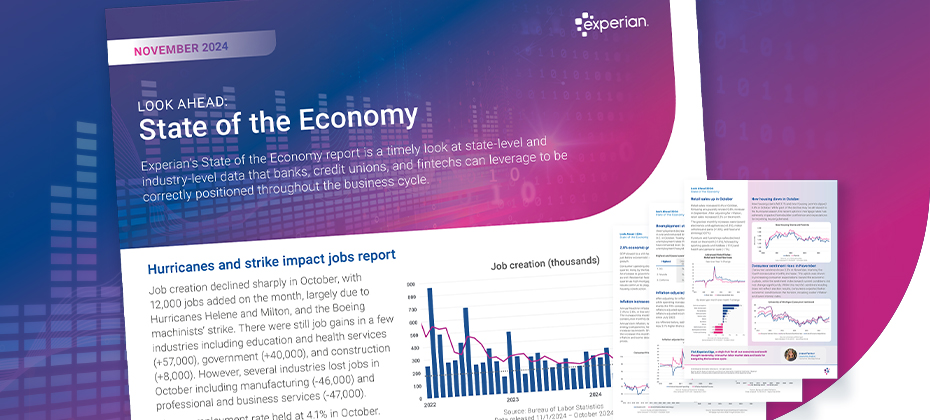
This series will explore our monthly State of the Economy report, which provides a snapshot of the top monthly economic and credit data for financial service professionals to proactively shape their business strategies. The U.S. economy remains on solid footing, as GDP grew at a healthy 2.8% rate in Q3, driven by consumer spending. Alongside growth, inflation ticked up, while the labor market eased across several measures. In response to these developments, the Federal Reserve announced a quarter-point cut in November, with another cut penciled in for December. The November State of the Economy report fills in the rest of the macroeconomic story. This month’s highlights include: Annual headline inflation ticked up from 2.4% to 2.6%. 12,000 jobs were added in October, amid hurricane and strike impacts. Retail sales increased by 0.4% in October. Check out the full report for a detailed analysis of the rest of this month’s data, including the latest trends in originations, job openings, and growth. Download November's report As our economy continues to fluctuate, it’s critical to stay updated on the latest developments. Subscribe to our new series, The Macro Moment, for economic commentary from Experian NA’s Chief Economist, Joseph Mayans, with additional economic resources, including our new Election Eve’s Scenario Forecasts report. For more economic trends and market insights, visit Experian Edge.
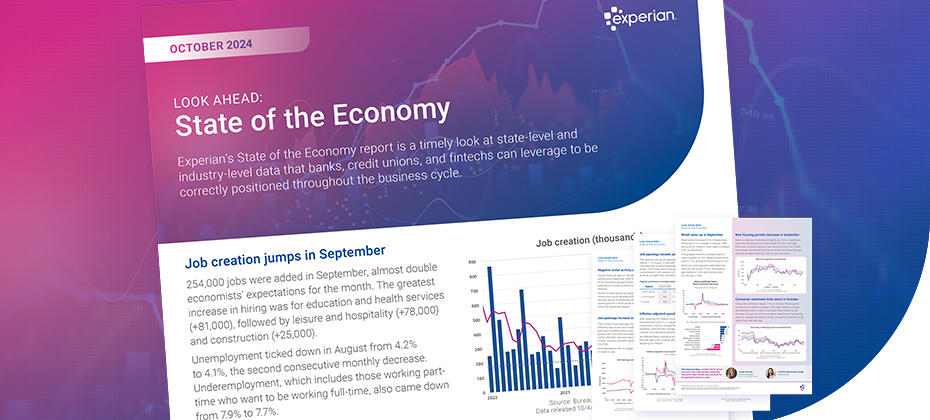
This series will explore our monthly State of the Economy report, which provides a snapshot of the top monthly economic and credit data for financial service professionals to proactively shape their business strategies. After the Federal Reserve announced its first cut since 2020 in September, several pieces of economic data have surpassed expectations. Job creation was almost double economists’ estimates, unemployment ticked down, and personal incomes were revised up. Alongside these areas of strength, inflation continued to prove stubborn. The October State of the Economy report fills in the rest of the developing macroeconomic story. This month’s highlights include: Unemployment decreased for the second month in a row, down to 4.1%. Core inflation increased from 3.2% to 3.3%, driven by shelter and service costs. Negative rental payment activity has declined 1.9% over the past year. Check out our report for a detailed analysis of the rest of this month’s data, including the latest trends in originations, retail sales, and consumer sentiment. Download October's report As our economy continues to fluctuate, it's critical to stay updated on the latest developments. Subscribe to our new series, The Macro Moment, for economic commentary from Experian NA’s Chief Economist, Joseph Mayans, with additional economic resources, including our new Lending Conditions Chartbook and our new Labor Market Monitor. For more economic trends and market insights, visit Experian Edge.
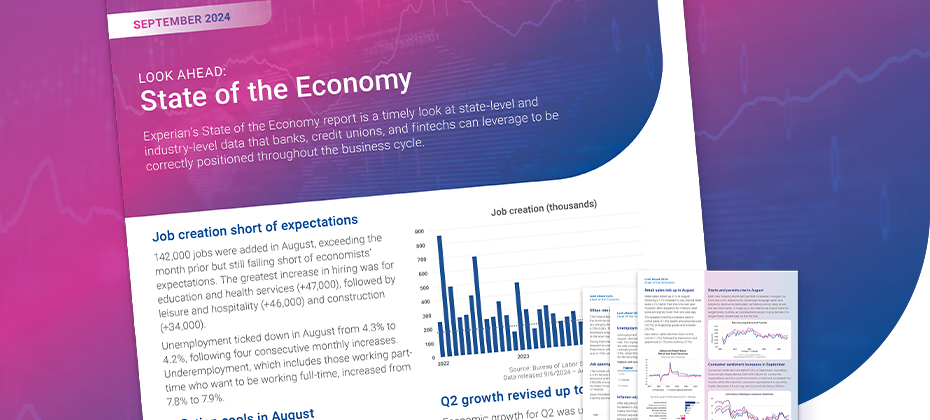
This series will explore our monthly State of the Economy report, which provides a snapshot of the top monthly economic and credit data for financial service professionals to proactively shape their business strategies. During their September meeting, the Federal Reserve made a highly-anticipated announcement to cut rates for the first time since 2020. Fed officials cut rates by 50bps, while also penciling in an additional 50bps of cuts for 2024 and 100bps of cuts in 2025 in their Summary of Economic Projections. While rates are coming down and inflation continues to cool, there were downward revisions to job creation made in August and declining job openings in July. Data highlights from this month’s report include: The Federal Reserve announced a 50bps rate cut during the September meeting. Annual headline inflation cooled from 2.9% to 2.5%, getting closer to the Fed’s 2% goal. Mortgage originations increased 7.0% in August. Check out our report for a deep dive into the rest of this month’s data, including the latest trends in job creation, retail sales, and consumer sentiment. Download September's report As our economy continues to fluctuate, it's critical to stay updated on the latest developments. Subscribe to our new series, The Macro Moment, for economic commentary from Experian North America's Chief Economist, Joseph Mayans, and download our new Lending Conditions Chartbook for additional insights. For more economic trends and market insights, visit Experian Edge.
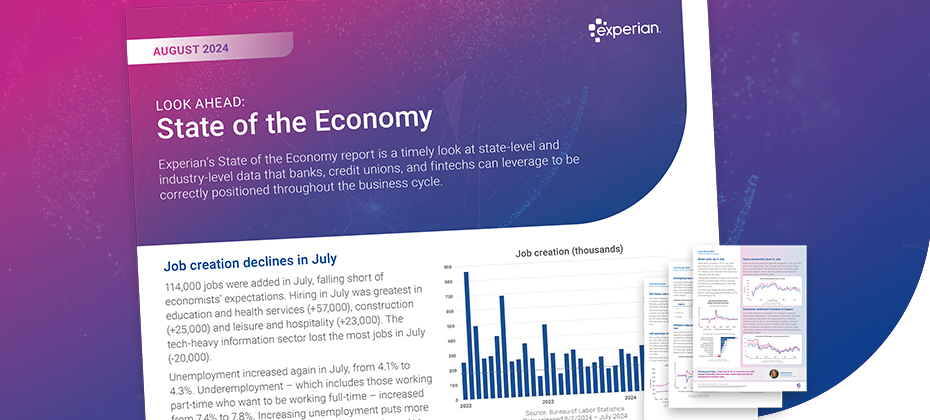
This series will dive into our monthly State of the Economy report, providing a snapshot of the top monthly economic and credit data for those in financial services to proactively shape their business strategies. The labor market has been a source of strength for the U.S. economy coming out of the pandemic, providing workers with stable employment and solid wages. However, the labor market has slowed in recent months, with lower-than-expected job creation and rising unemployment, causing weakening sentiment in the broader market. This has resulted in increased pressure on the Federal Reserve to begin cutting rates and places more importance on the incoming data between now and the September FOMC meeting. Data highlights from this month’s report include: Job creation declined in July, falling short of economists’ expectations. Unemployment increased from 4.1% to 4.3%. Inflation cooled again in July, with annual headline inflation easing from 3.0% to 2.9%. GDP picked up in Q2 to 2.8%, primarily driven by strong consumer spending. Check out our report for a deep dive into the rest of this month’s data, including the latest trends in originations, retail sales, and the new housing market. Download August's report To have a holistic view of our current environment, it’s important to view the economy from different angles and through different lenses. Download our latest macroeconomic forecasting report for our views on what's to come in the U.S. economy and listen to our latest Econ to Action podcast. For more economic trends and market insights, visit Experian Edge.
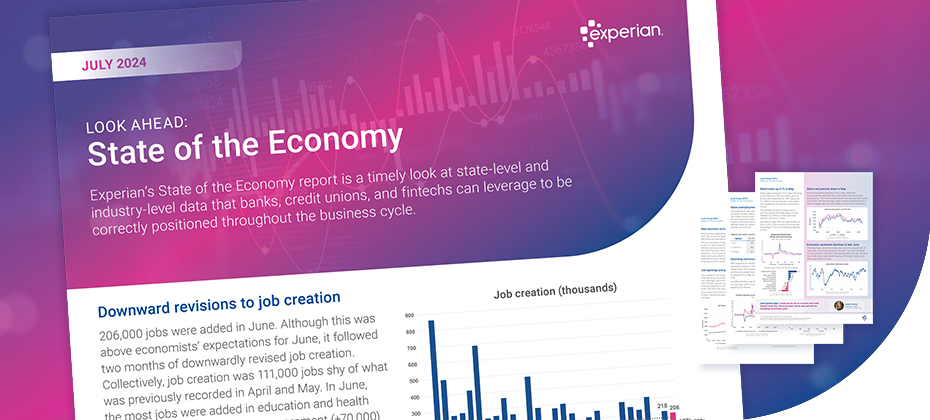
This series will dive into our monthly State of the Economy report, providing a snapshot of the top monthly economic and credit data for those in financial services to proactively shape their business strategies. While much of the economic data released this month remained steady, including continued downward progress in inflation and resilience in inflation-adjusted spending, June was a pivotal month for the labor market. With downward revisions to job creation over the past few months to an up-tick in unemployment, the potential for a sooner-than-expected rate cut increased. Data highlights from this month’s report include: While above economists’ expectations in June, job creation was 111,000 jobs shy of what was recorded in April and May, signaling some slowdown in the labor market. Inflation-adjusted spending and incomes increased in May, by 0.3% and 0.5%, respectively. Inflation eased more than economists expected, with annual headline inflation cooling from 3.3% to 3.0%. Check out our report for a deep dive into the rest of this month’s data, including the latest trends in job openings, new business survival rates, and bankcard delinquency rates. Download July's report To have a holistic view of our current environment, it’s important to view the economy from different angles and through different lenses. Watch our experts discuss the latest economic and credit trends in the next macroeconomic forecasting webinar and listen to our latest Econ to Action podcast. For more economic trends and market insights, visit Experian Edge.
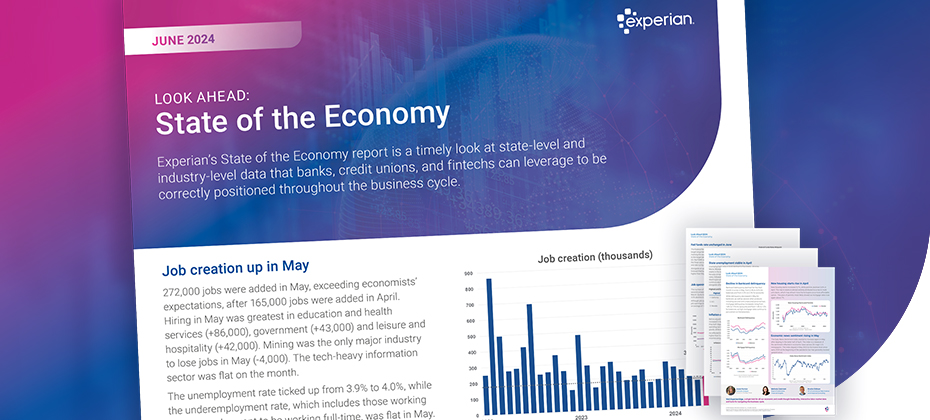
This series will dive into our monthly State of the Economy report, providing a snapshot of the top monthly economic and credit data for those in financial services to proactively shape their business strategies. During their June meeting, the Federal Reserve continued to hold rates steady and released an updated Summary of Economic Projections. In this update, the committee reduced 2024 rate cut projections from three to one and increased their year-end inflation expectations. Both of these updates were likely driven by a lack of downward progress in inflation in Q1. But as the Federal Reserve extends the period of restrictive rates, it places more weight on each monthly economic data release to inform the Fed’s next move. Data highlights from this month’s report include: Job creation exceeded economists’ expectations with 272,000 jobs added in May. Inflation cooled in May, with annual headline inflation down from 3.4% to 3.3% and annual core inflation down from 3.6% to 3.4%. Auto loan amounts decreased in Q1 as inventories continue to stabilize. Check out our report for a deep dive into the rest of this month’s data, including the latest trends in delinquencies, spending, and the new housing market. Download June's report To have a holistic view of our current environment, it’s important to view the economy from different angles and through different lenses. Watch our experts discuss the latest economic and credit trends in the recording of our latest macroeconomic forecasting webinar and listen to our latest Econ to Action podcast. For more economic trends and market insights, visit Experian Edge.
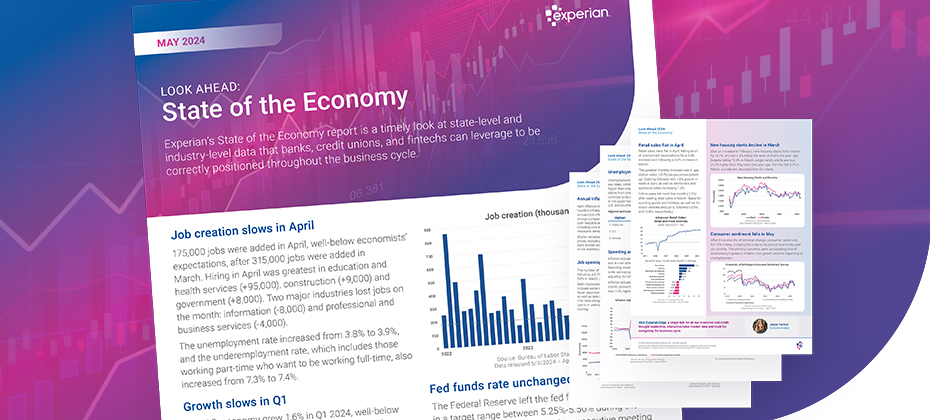
This series will dive into our monthly State of the Economy report, providing a snapshot of the top monthly economic and credit data for those in financial services to proactively shape their business strategies. After again announcing no change in the target fed funds rate during their May meeting, the Federal Reserve continues to face the decision of when to begin cutting rates. The economic data released this month only complicated this decision, as growth came in well-below expectations and the labor market seemed to ease on several fronts. However, there was only minimal downward progress in inflation, especially considering the high prices seen over the past few months. In this month’s report, we dive into the data developments that comprise this economic story. Data highlights from this month’s report include: Economic growth in Q1 came in at 1.6%, under economists’ expectations. Underlying components of consumer spending and business investment remained solid. Inflation cooled in April, with annual headline inflation down from 3.5% to 3.4% and annual core inflation down from 3.8% to 3.6%. Consumer sentiment fell 13% in May, due to stubborn inflation, low growth, and easing in the labor market. Check out our report for a deep dive into the rest of this month’s data, including the latest trends in job creation, spending, and the fed funds rate. Download May's State of the Economy report To have a holistic view of our current environment, it’s important to view the economy from different angles and through different lenses. Watch our team of experts discuss the latest economic and credit trends in the recording of our latest macroeconomic forecasting webinar, download our latest forecast scenario report, or listen to our latest Econ to Action podcast for views on the economic environment in different market segments. For more economic trends and market insights, visit Experian Edge.
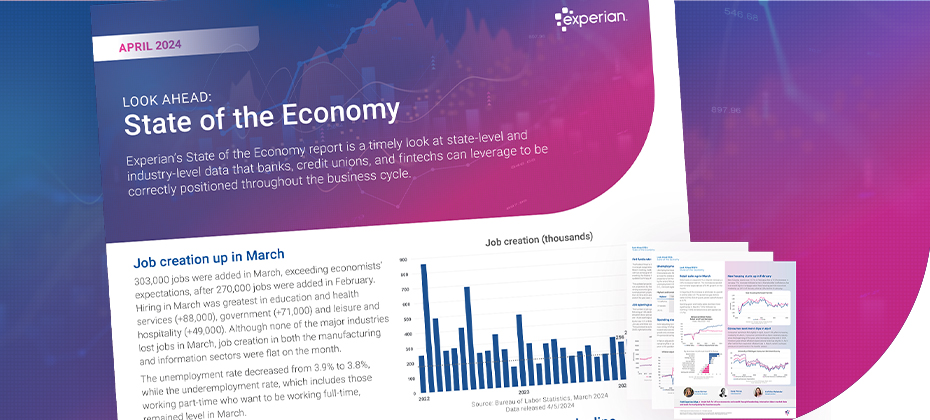
This series will dive into our monthly State of the Economy report, providing a snapshot of the top monthly economic and credit data for those in financial services to proactively shape their business strategies. During their March meeting, the Federal Reserve announced no change in the federal funds rate and released their updated Summary of Economic Projects for the remainder of 2024 and 2025. In response to slow but steady cooling inflation, they maintained projections for three rate cuts by the end of 2024. Additionally, they upgraded their growth projections and lowered their unemployment projections, signaling more optimism toward the U.S. economic trajectory. In this month's report, we dive into the data developments that are contributing to this economic story. Data highlights from this month's report include: The Federal Reserve held rates steady and maintained projections for three rate cuts by the end of the year. Inflation progress slowed, with annual headline inflation flat and annual core inflation ticking up from 3.2% to 3.5%. The median rent-to-income ratio increased 4.1% year-over-year to 37.9% nationally. Check out our report for a deep dive into the rest of April's data, including the latest trends in income, originations, and job creation. To have a holistic view of our current environment, we must understand our economic past, present, and future. Check out our annual chartbook for a comprehensive view of the past year and register for our upcoming macroeconomic forecasting webinar for a look at the year ahead. Download April's State of the Economy report Register for webinar For more economic trends and market insights, visit Experian Edge.

Current economic conditions present genuine challenges for mortgage lenders. In this environment, first-time homebuyers offer exciting, perhaps unexpected, business growth potential. Market uncertainties have kept potential borrowers anxious and on the sidelines. The Federal Reserve's recent announcement that interest rates will remain steady for now has added to borrower anxiety. First-time homebuyers are no exception. They are concerned about the “right” time to jump in, buy a home, and own a mortgage. Despite worries over high interest rates and low inventory, many first-time homebuyers are tired of waiting for rates to drop and inventory to blossom. First-time buyers are eager to explore all avenues necessary to achieve homeownership. They show a willingness to be flexible when it comes to finding a house, considering options like a fixer upper or expanding their search to more affordable locations. The desire to escape the uncertainty and financial burden of renting is a strong driving force for first-time buyers. They see homeownership as a way to establish stability and build equity for their future. Despite the obstacles renters face in the competitive housing market, these potential buyers are motivated. Lenders who take time to understand who these buyers are and what matters to them will be ahead of the game. Notwithstanding stubbornly high interest rates, first-time homebuyers historically have shown remarkable resilience amid market fluctuations. According to a recent deep dive by Experian Mortgage experts into the buying patterns of first-time homebuyers, this group made 35-48% of all new purchases and 8-12% of all refinances between July 2022 and September 2023. First-time buyers represent both immediate potential and long-term client opportunities. How can lenders attract first-time homebuyers and drive growth from this market? The first-time homebuyer market largely consists of individuals in their early 40s and younger, also known as Gen Y and Gen Z. Rising costs of renting a home frustrate these individuals who are trying to save money for a down payment on a house and ultimately, buy their dream home. They want to settle down and look ahead to the future. For mortgage lenders who focus on understanding this younger first-time buyer market and developing targeted business strategies to attract them, great growth potential exists. Often, younger people feel locked out of buying opportunities, which creates uncertainty and apprehension about entering the market. This presents mortgage industry professionals with an incredible opportunity to show their value and grow their client base. To attract this market segment, lenders must adapt. Lenders must develop a comprehensive picture of this younger generation. Who are they? How do they shop? Where do they want to live? What is their financial situation? What are their financial and personal goals? Acknowledging difficulties in the housing market and showing them a well-conceived path forward to home ownership will win the day for the lender and the buyer. As interest rates are poised to decrease in 2024-2025, there is potential for a surge in demand from first-time homebuyers. Lenders should prepare for these potential buyers, now. It is crucial to reevaluate how to approach first-time buyers to identify new opportunities for expansion. Experian Mortgage examined first-time homebuyer trends to pinpoint prospects with good credit and provide analysis on potential areas of opportunity. For more information about the lending possibilities for first-time homebuyers, download our white paper. Download white paper
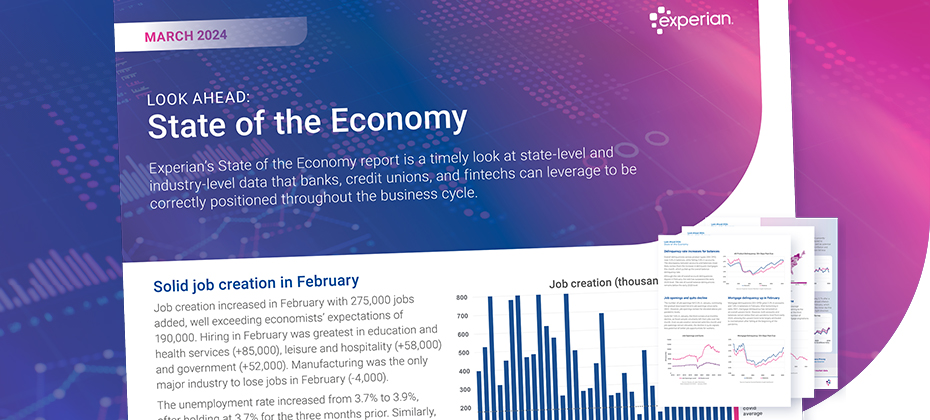
This series will dive into our monthly State of the Economy report, providing a snapshot of the top monthly economic and credit data for those in financial services to proactively shape their business strategies. As we near the end of the first quarter, the U.S. economy has maintained its solid standing. We're also starting to see some easing in a few areas. This month saw a slight uptick in unemployment, slowed spending growth, and a slight increase in annual headline inflation. At the same time, job creation was robust, incomes continued to grow, and annual core inflation cooled. In light of the mixed economic landscape, this month’s upcoming Federal Reserve meeting and their refreshed Summary of Economic Projections should shine some light on what’s in store in the coming months. Data highlights from this month’s report include: Annual headline inflation increased from 3.1% to 3.2%, while annual core inflation cooled from 3.9% to 3.8%. Job creation remained solid, with 275,000 jobs added this month. Unemployment increased to 3.9% from 3.7% three months prior. Mortgage delinquencies rose for accounts (2.3%) and balances (1.8%) in February, contributing to overall delinquencies across product types. Check out our report for a deep dive into the rest of March’s data, including consumer spending, the housing market, and originations. To have a holistic view of our current environment, we must understand our economic past, present, and future. Check out our annual chartbook for a comprehensive view of the past year and download our latest forecasting report for a look at the year ahead. Download March's State of the Economy report Download latest forecast For more economic trends and market insights, visit Experian Edge.
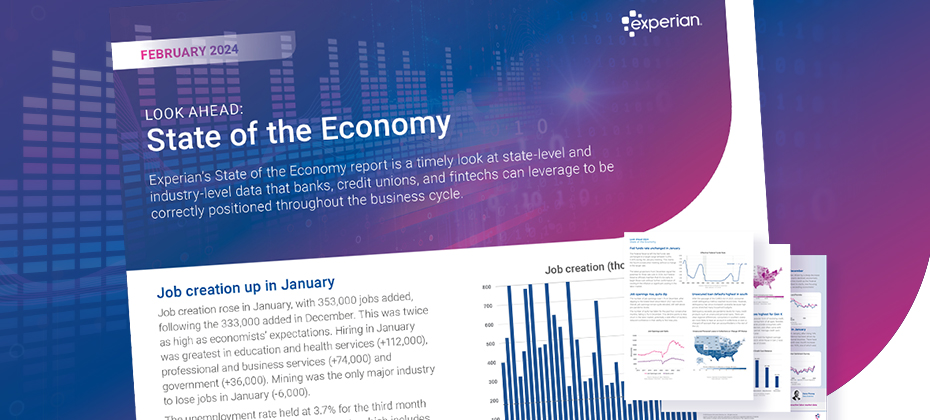
This series will dive into our monthly State of the Economy report, providing a snapshot of the top monthly economic and credit data for those in financial services to proactively shape their business strategies. In February, economic growth and job creation outperformed economists’ expectations, likely giving confirmation to the Federal Reserve that it remains too early to begin cutting rates. Data highlights from this month’s report include: U.S. real GDP rose 3.3% in Q4 2023, driven by consumer spending and bringing the average annual 2023 growth to 2.5%, the same as the five-year average growth prior to the pandemic. The labor market maintained its strength, with 353,000 jobs added this month and unemployment holding at 3.7% for the third month in a row. Consumer sentiment rose 13% in January, following a 14% increase in December, as consumers are feeling some relief from cooling inflation. Check out our report for a deep dive into the rest of February’s data, including inflation, the latest Federal Reserve announcement, the housing market, and credit card balances. To have a holistic view of our current environment, we must understand our economic past, present, and future. Check out our annual chartbook for a comprehensive view of the past year and register for our upcoming Macroeconomic Forecasting webinar for a look at the year ahead. Download report Register for webinar For more economic trends and market insights, visit Experian Edge.